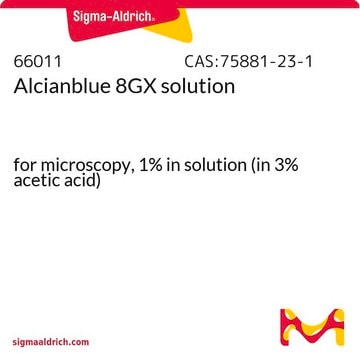A5268
Alcian Blue 8GX
powder
Sinónimos:
Alcian Blue, Ingrain Blue 1
About This Item
Productos recomendados
form
powder
Quality Level
composition
Dye content, 45-65%
color
blue
solubility
H2O: 1 mg/mL
εmax
425 at 615-630 nm in water
application(s)
diagnostic assay manufacturing
hematology
histology
storage temp.
room temp
SMILES string
[Cl-].[Cl-].[Cl-].[Cl-].CN(C)C(\SCc1ccc2c3nc(nc4n5[Cu]n6c(nc7nc(nc5c8cc(CS\C(N(C)C)=[N+](\C)C)ccc48)c9ccc(CS\C(N(C)C)=[N+](\C)C)cc79)c%10ccc(CS\C(N(C)C)=[N+](\C)C)cc%10c6n3)c2c1)=[N+](/C)C
InChI
1S/C56H68N16S4.4ClH.Cu/c1-65(2)53(66(3)4)73-29-33-17-21-37-41(25-33)49-57-45(37)62-50-43-27-35(31-75-55(69(9)10)70(11)12)19-23-39(43)47(59-50)64-52-44-28-36(32-76-56(71(13)14)72(15)16)20-24-40(44)48(60-52)63-51-42-26-34(18-22-38(42)46(58-51)61-49)30-74-54(67(5)6)68(7)8;;;;;/h17-28H,29-32H2,1-16H3;4*1H;/q+2;;;;;+2/p-4
InChI key
CKLBXIYTBHXJEH-UHFFFAOYSA-J
¿Está buscando productos similares? Visita Guía de comparación de productos
Categorías relacionadas
General description
application
- Alcian Blue 8GX has been used for the staining and precipitation of glycosaminoglycans and as a heteroglycan stain for neutral, sulfated, and phosphated mucopolysaccharides and glycosaminoglycans in tissues such as cartilage and extracellular matrices.
- It has been employed in the in vivo visualization of intravascular Bonghan ducts and corpuscles in murine models.
- It has been used to develop a novel histochemical staining method to assess multiple respiratory parameters in various species.
Features and Benefits
Principle
Storage Class
11 - Combustible Solids
wgk_germany
WGK 3
flash_point_f
Not applicable
flash_point_c
Not applicable
ppe
Eyeshields, Gloves, type N95 (US)
Certificados de análisis (COA)
Busque Certificados de análisis (COA) introduciendo el número de lote del producto. Los números de lote se encuentran en la etiqueta del producto después de las palabras «Lot» o «Batch»
¿Ya tiene este producto?
Encuentre la documentación para los productos que ha comprado recientemente en la Biblioteca de documentos.
Nuestro equipo de científicos tiene experiencia en todas las áreas de investigación: Ciencias de la vida, Ciencia de los materiales, Síntesis química, Cromatografía, Analítica y muchas otras.
Póngase en contacto con el Servicio técnico






